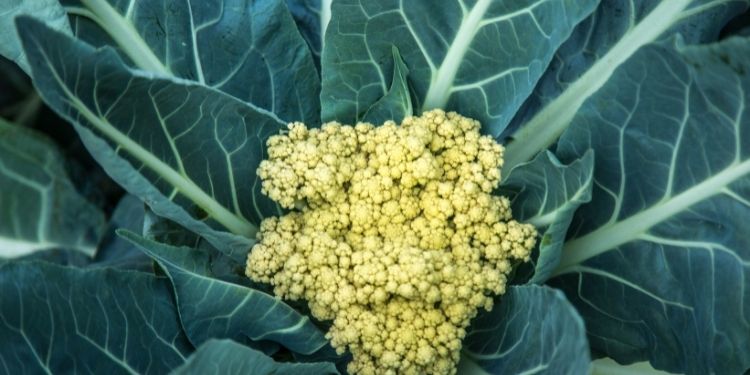Cauliflower Cultivation in India Guide to Cauliflower product

Cauliflower is the most prominent winter vegetable farmers grow in India. It is a European native, possibly developed from broccoli. They cultivate cauliflower in almost all the states in India, but the main states are Bihar, Uttar Pradesh, Orissa, Assam, Madhya Pradesh, Gujarat and Haryana. The scientific name of cauliflower is Brassica oleracea var botrytis. It is a core and popular vegetable in different parts of the world.
Farmers can sow direct cauliflower crops for autumn harvest 8 to 12 weeks before the first expected frost in the fall. Implants come to maturity in 55 to 80 days; From seed, cauliflower requires 70 to 120 days. Cauliflower is a cool-season semi-hardy biennial that is grown as an annual. Farmers grow the cauliflower for the edible buds that form a solid head on top of a stalk. The head is sometimes called curd. The heads can be cream, white, purple or green. Broccoli flower is a hybrid cross between cauliflower and broccoli; Brocco Flowers have green heads.
The procedure of growing cauliflower farmers needs the most prominent equipment that is the tractor. Therefore we suggest the New Holland 3600 tractor. This tractor is the most efficient in the field.
Table of Contents
ToggleSoil Requirement For Cauliflower Cultivation
Cauliflower needs a cool, moist climate. Early varieties can tolerate high temperatures and long days. Farmers can grow it in plains from September to February. For cauliflower cultivation, deep loamy soil with a pH range of 5.5 to 6.6, high in organic matter, and good drainage.
Planting Cauliflower
Cauliflower grows ideal in rich, well-drained, moisture-retentive. The pH soil of cauliflower ranges from 6.5 to 8.0. Plant the cauliflower vegetable in full sun. Broccoflower prefers partial shade. Before sowing, apply old manure to the sown beds.
Cauliflower Planting Time
Cauliflower needs 55 to 100 days of cool, even temperatures, to reach harvesting. Start cauliflower seeds indoors 6 to 10 weeks before the last frost in spring. Cauliflower germinates at 45°F (7°C). Farmers usually grow cauliflower from transplants. You can transplant in the garden 2 to 6 weeks before the last frost, usually 6 weeks after sowing when the plant has 4 to 5 true leaves.
Plant cauliflower directly in the garden where soil temperatures are between 65°F and 75°F (18-24°C), and the weather will be cool. Crops for autumn harvest can be directly sown 8 to 12 weeks before the first expected frost in the fall. Cauliflower does not like extreme temperatures, hot or cold; It does not tolerate dry conditions—plant the cauliflower in autumn for a harvest where winter is frost-free. Excessive temperatures will cause the cauliflower to bolt and go to seed.
Cauliflower Planting and Spacing
Sow cauliflower seeds 1 inch deep and 2 to 3 inches (2.5–7.6 cm) apart. Thin plants 15 to 24 inches (38-61cm) apart; Space rows 24 to 30 inches (61-76cm) apart. Set transplants with leggy or stunted stems deep enough to their first leaves, so they don’t become over-heavy. For succession crops, plant a couple of ends at a time or plant early and mid-season varieties simultaneously.
Caring for Cauliflower
Cauliflower needs moist soil for uninterrupted head formation, vigorous growth. You don’t need to dry out the ground. However, add aged manure to the planting bed before sowing and in mid-season as a side dressing.
Keep the planting of cauliflower beds free of weeds. Avoid the way of deep cultivation, which can damage the roots. White cauliflower is blanched to keep the head white and to protect the head from rain and too much sunlight.
Blanching doesn’t improve the taste much—Blanch white cauliflower varieties when the head is the size of an egg. Then, three or four leaves from over the head and secure them with a clothespin or rubber band. Check the heads weekly to ensure pests are not hiding under the leaves. Self-blanching cauliflower does not need to be plucked, but it will not swell in hot weather.
Cauliflower Diseases
Cauliflower is susceptible to root rot – an early symptom is yellowing leaves. Plant disease-resistant varieties, retain the garden free from debris and avoid the plants handling when they are wet. Remove and destroy infected plants immediately so that they do not spread the disease to healthy plants. Downy mildew that occurs in cool, wet conditions can turn cauliflower heads brown.
Cauliflower Pests
Any pests can attack the cauliflower, such as cutworms, cabbage loopers (preceded by small yellow and white moths), and imported cabbage worms. You can control these pests by handpicking, row covers and spraying with Bacillus Thuringiensis.
Harvesting Cauliflower
The ideal time from planting to harvesting is 55 to 100 days to grow the cauliflower from seedlings and 85 to 130 days for cauliflower. Under growing conditions, heads rapidly develop to about six to eight inches in diameter. The mature head should be compact, firm and white. First, cut off the entire head from the main stem. Then, you can cook leaves like collards or cabbage.
Farming requires the most important type of equipment, which plays a major role in agro-processing. Equipment, harvesters and tractors are the major ones in cauliflower cultivation; Hence, we suggest the New Holland 3630 Tractor, which is better for increasing efficiency in the field.
For more information regarding cauliflower farming, stay tuned with us.
Tony Lanzap, a distinguished astrologer, possesses a profound understanding of celestial patterns. With years of experience, he has honed his skills in interpreting the cosmos to provide insightful guidance. Tony's unique approach blends traditional wisdom with modern insights, making him a sought-after expert in the realm of astrology. His commitment to helping individuals navigate life's journey has earned him acclaim and trust among those seeking cosmic clarity.
Recommended For You
Spread the loveThe name Broderick Bevineau makes you think of new ideas and starting your own business. Bevineau has made
Spread the loveThe popularity of Airbnb has paved the way for many entrepreneurs to build businesses in the short-term rental
Spread the loveCreating a well-designed and functional website starts long before coding begins. The prototyping phase is a critical step




